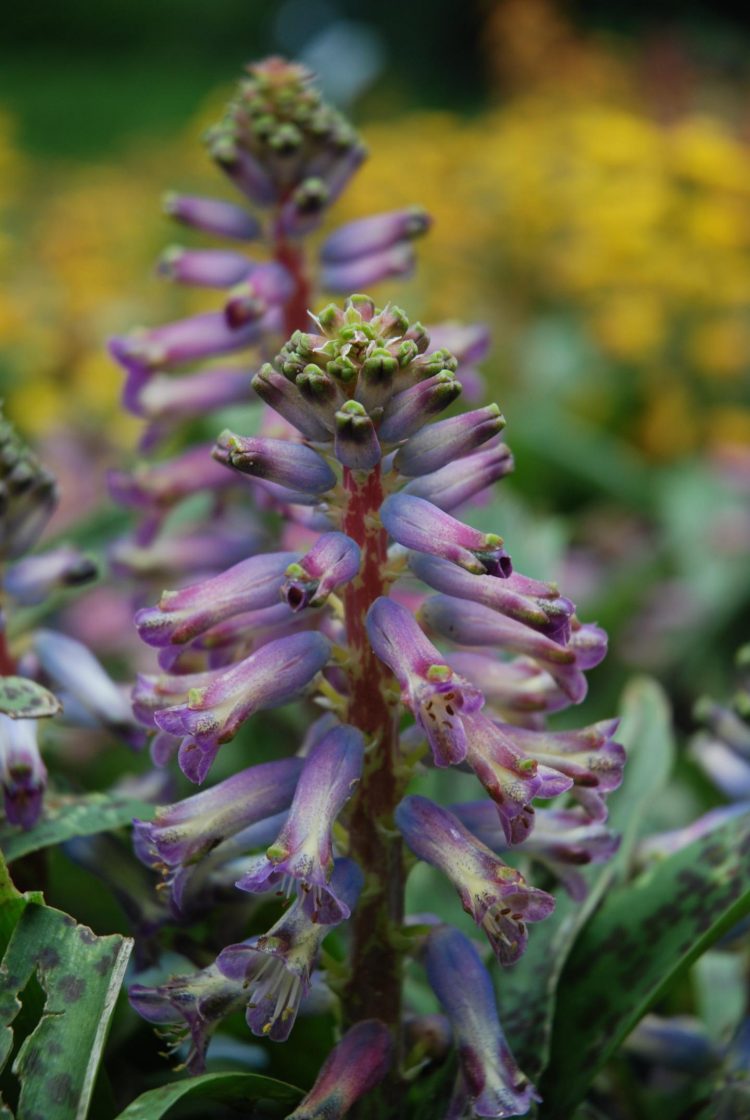Planting time, flurprimidol treatments recommended for Lachenalia

Flurprimidol treatment influenced the inflorescence stem height and floret length of 'Rupert', and the latest planting date in the experiments produced the shortest plants. Photo courtesy of Anna Kapczyńska
In order to introduce new flowering plants to market, breeders and growers need proven strategies for producing healthy, compact plants during times of highest consumer demand. Determining optimal planting times to produce true-to-type, high-quality potted plants or cut flowers also translates to higher revenues for growers. A new study in June 2016 issue of HortTechnology offers recommendations about production practices for lachenalia, an ornamental plant that is gaining popularity among consumers.
Researchers Anna Kapczyńska and Małgorzata Malik, from the University of Agriculture in Kraków, said that interest in lachenalia is growing because of it rich palette of flower colors and unique spotted leaves. “Lachenalias have the potential to become an extremely attractive pot plant or cut flower given their variations in flower color and longevity,” the authors said.
Kapczyńska and Malik investigated how applications of the plant growth regulator flurprimidol would affect the growth of 'Ronina' and 'Rupert' lachenalia. Bulbs were planted in November, December, January, and February. At each planting date, the researchers applied flurprimidol treatments either by soaking the bulbs before planting or by a single foliar spray at four different concentrations.
Analyses showed that all growth parameters tested (except the number of leaves) were influenced by the planting date; the shortest plants were obtained by planting bulbs on the latest date. The application of flurprimidol and its concentration affected length and width of leaves and number of days to flowering of both types of lachenalia.
Flurprimidol treatment influenced the inflorescence stem height and floret length of 'Rupert': the shortest and the widest leaves resulted from bulbs soaked in flurprimidol at 30 mg·L-1. Flurprimidol treatment reduced the first and second leaf length by 18% and 17% for 'Ronina' and 23% and 23% for 'Rupert', and increased the first and second leaf width by 13% and 15% for 'Ronina' and 17% and 20% for 'Rupert'. Compared with control plants, soaking the bulbs and spraying the leaves of 'Ronina' delayed the emergence of flowers for 3-5 days and 1-4 days, respectively.
“We recommend soaking bulbs in flurprimidol at the concentration of 30 mg·L-1 to improve plant appearance and marketing quality,” Kapczyńska and Malik said.
The experiments also showed that day length greatly influences the growth and flowering of lachenalia plants. “Prospective growers should also consider the need for supplemental lighting during autumn-winter cultivation,” the authors noted.
###
The complete study and abstract are available on the ASHS HortTechnology electronic journal web site: http://horttech.
Founded in 1903, the American Society for Horticultural Science (ASHS) is the largest organization dedicated to advancing all facets of horticultural research, education, and application. More information at ashs.org
Media Contact
All latest news from the category: Agricultural and Forestry Science
Newest articles

Bringing bio-inspired robots to life
Nebraska researcher Eric Markvicka gets NSF CAREER Award to pursue manufacture of novel materials for soft robotics and stretchable electronics. Engineers are increasingly eager to develop robots that mimic the…

Bella moths use poison to attract mates
Scientists are closer to finding out how. Pyrrolizidine alkaloids are as bitter and toxic as they are hard to pronounce. They’re produced by several different types of plants and are…

AI tool creates ‘synthetic’ images of cells
…for enhanced microscopy analysis. Observing individual cells through microscopes can reveal a range of important cell biological phenomena that frequently play a role in human diseases, but the process of…





















